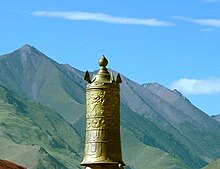Dhvaja


Dhvaja(Sanskrit:ध्वज,romanized:Dhvaja,lit. 'flag';Tibetan:རྒྱལ་མཚན,Wylie:rgyal-msthan) is theSanskritterm for a banner or aflag.Flags are featured in the iconography, mythology, and architecture of Indian religions such asBuddhism,Hinduism,andJainism.They are one of theashtamangala,the eight auspicious emblems of these religions.[1]
Hinduism
[edit]InHindu iconography,deities are often portrayed with flags, often represented carried or present alongside theirmounts.Such flags are often venerated due to their association of a given deity, and also due to the fact that they are regarded to be imbued by their divine attributes. A flag staff or a votive column (dhvajastambha) is often erected in front oftemplesor on top of their roofs.[2]These columns are regarded to symbolise theworld axis,[3]and a pillar between earth andheaven.[4]
A chapter from the epicMahabharatadescribes the various flags and their devices borne by the warriors of theKurukshetra War:[5]
- Abhimanyu- Deer
- Arjuna-Hanuman
- Ashvatthama- Lion's tail with golden rays
- Bharata- Tree
- Bhima- Lion
- Bhishma- Tree
- Drona-Kamandalu
- Duryodhana- Serpent
- Ghatotkacha- Wheel
- Indra- Sword
- Jayadratha- Boar
- Kama-Makara
- Karna- Elephant
- Kartikeya-Peacock
- Kripa- Bull
- Nakula- Deer
- Sahadeva- Swan
- Shiva-Nandi
- Vishnu-Garuda
- Yudhishthira- Moon
Tibetan architecture
[edit]
Within theTibetantradition, a list of eleven different forms of the victory banner is given to represent eleven specific methods for overcoming "defilements" (Sanskrit:klesha). Many variations of the dhvaja's design can be seen on the roofs ofTibetanmonasteries (Gompa,Vihara) to symbolize the Buddha's victory over four maras.
In its most traditional form, the victory banner is fashioned as a cylindrical ensign mounted upon a long wooden axel-pole. The top of the banner takes the form of a small white "parasol"(Sanskrit:chhatra), which is surrounded by a central "wish granting gem" (Sanskrit:cintamani). This domed parasol is rimmed by an ornate golden crest-bar or moon-crest withmakara-trailed ends, from which hangs a billowing yellow or "white silk scarf'" (Sanskrit:khata) (see top right).
As a hand-held ensign, the victory banner is an attribute of manydeities,particularly those associated with wealth and power, such asVaiśravaṇa,the Great Guardian King of the north. As a roof-mounted ensign, the victory banners are cylinders usually made of beaten copper (similar totoreutics) and are traditionally placed on the four corners of monastery and temple roofs. Those roof ornaments usually take the form of a small circularparasolsurmounted by the wish-fulfilling gem, with four or eight makara heads at the parasol edge, supporting little silver bells (see the Jokhang Dhvaja on the left). A smaller victory banner fashioned on a beaten copper frame, hung with black silk, and surmounted by a flaming "trident"(Sanskrit:trishula) is also commonly displayed on roofs (see the dhvaja on the roof of the Potala Palace below).[6][7]

-
Five Dhvajas (Victory banners), on the roof of thePotalaWhite Palace.
-
Dhvaja (Victory banner) - trident design with black silk, roof of thePotala Palace.
-
Dhvaja (Victory banner), Roof of Potala Palace.
-
A Dhvaja from Hinduism.
History
[edit]Dhvajas are probably depicted inIndus Valley Civilizationseals, one Indus seal depicts four men carrying variously shaped djvajas or standards[8]and later also on cast copper coins from the early historic period of the Indian Sub continent.[9]Heliodorus pillarinscription also declares the pillar to be Garudadhvaja orGarudastandard.
-
Indus seal mold depicting Dhvaja like object in front of the unicorn
-
Jayadhvaja or triangular standard depicted on aShungacopper cast coin, 2nd-1st century BC
-
Heliodorus pillar,as Garudadhvaja or Garuda standard, circa 100 BC
-
Shunga horseman carrying a portabledhvaja,Barhut,circa 100 BC
Saffron flags
[edit]
The coloursaffron coloris considered sacred in theIndian religionsofHinduism,Jainism,Buddhism,andSikhism.Other flags incorporating the saffron colour based on Indian religions are:
- Religion
- Dhvajasthamba,flagpole in Hinduism
- Bhagwa Dhwaj,the Maratha flag associated with Hinduism
- Nishan Sahibin Sikhism
- Nations
See also
[edit]References
[edit]- ^Byghan, Yowann (2020-03-12).Sacred and Mythological Animals: A Worldwide Taxonomy(in Bengali). McFarland. p. 279.ISBN978-1-4766-3887-4.
- ^Stutley, Margaret (2019-04-09).The Illustrated Dictionary of Hindu Iconography.Routledge. p. 126.ISBN978-0-429-62425-4.
- ^Werner, Karel (2005-08-11).A Popular Dictionary of Hinduism.Routledge. p. 41.ISBN978-1-135-79753-9.
- ^Nugteren, Albertina (2018-08-14).Belief, Bounty, and Beauty: Rituals around Sacred Trees in India.BRILL. p. 32.ISBN978-90-474-1561-9.
- ^Walker, Benjamin (2019-04-09).Hindu World: An Encyclopedic Survey of Hinduism. In Two Volumes. Volume I A-L.Routledge. p. 408.ISBN978-0-429-62421-6.
- ^A Handbook of Tibetan Buddhist Symbols by Robert Beer, Shambhala, 2003, p.13
- ^The Encyclopedia of Tibetan Symbols and Motifs by Robert Beer, Shambhala, 1999, p.180
- ^The Indian Historical Quarterly.Ramanand Vidya Bhawan. 1985.
- ^"NMMA".nmma.nic.in.Retrieved2019-05-30.
External links
[edit] Media related toDhvajaat Wikimedia Commons
Media related toDhvajaat Wikimedia Commons








